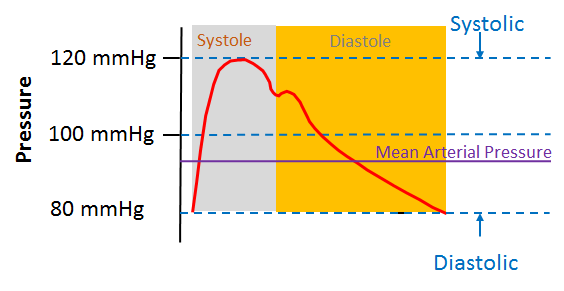Heart Stroke Work
Tags | |
UUID | f7498b41-d455-11e3-b7aa-bc764e2038f2 |
The Heart Stroke Work calculator computes the amount of work performed by the heart during a single heartbeat to pump blood based on the Mean Arterial Pressure (MAP) and Stroke Volume(SV).
INSTRUCTIONS: Choose units and enter the following:
- (SV) Stroke Volume
- (MAP) Mean Arterial Pressure
Heart Stroke Work (SW): The work is returned in Joules and mL⋅mmHL However, these can be automatically converted to compatible units via the pull-down menu.
The Math / Science
The Stroke Work [MAP,SV] equation computes the measurement of how much energy is converted to work by the heart, where:
SW = SV * MAP
where:
- SW=Stroke Work
- SV=Stroke Volume
- MAP = mean arterial pressure

The stroke work is the product of the mean arterial pressure (MAP) (the average blood pressure throughout the cardiac cycle (average ( 100 mmHg) ) and the stroke volume (the amount of blood pushed into the aorta with each beat of the heart (end-diastolic - end-systolic)). Together, the systolic pressure, stroke volume, cardiac output, stroke work, and cardiac work represents the ability of the ventricle to function as a pump (known as the Frank-Starling relation). The stroke work is the left ventricular work/beat. The right ventricle is only one-seventh of the left ventricle because of pulmonary vascular resistance is less than the systematic vascular resistance. The stroke work can also be found through mechanical efficiency and arterial inefficiency.
Heart Stroke Volume
The normal range of Stroke Volume (SV) in a healthy adult is typically 60–100 mL per beat. However, this value depends on factors like body size, fitness level, and cardiac function.
Variations in Stroke Volume:
- Higher SV (~100–150 mL):
- Found in well-trained athletes
- Can occur due to physiological adaptations (e.g., endurance training)
- Lower SV (<60 mL):
- May indicate heart failure, dehydration, or blood loss
- Can be due to conditions like cardiomyopathy or valvular disease
Indexed Stroke Volume (SVI)
Since body size affects SV, it is sometimes indexed to body surface area (BSA):
SVI=Stroke Volume (mL)Body Surface Area(m2)
Normal SVI range: 33–47 mL/m²
Mean Arterial Pressure
he normal range for Mean Arterial Pressure (MAP) is 70–100 mmHg (typically considered normal and adequate for organ perfusion)
Key Thresholds:
- MAP > 60 mmHg → Minimum required to perfuse vital organs (brain, kidneys, heart)
- MAP < 60 mmHg → Can indicate shock, organ hypoperfusion, or circulatory failure
- MAP > 100 mmHg → May suggest hypertension, increased cardiac workload, or risk of vascular damage
Formula to Calculate MAP:
MAP=Diastolic BP+13(Systolic BP−Diastolic BP)
Example: If BP = 120/80 mmHg
MAP=80+13(120−80)=80+13.3=93.3 mmHg
- Comments
- Attachments
- Stats
No comments |
